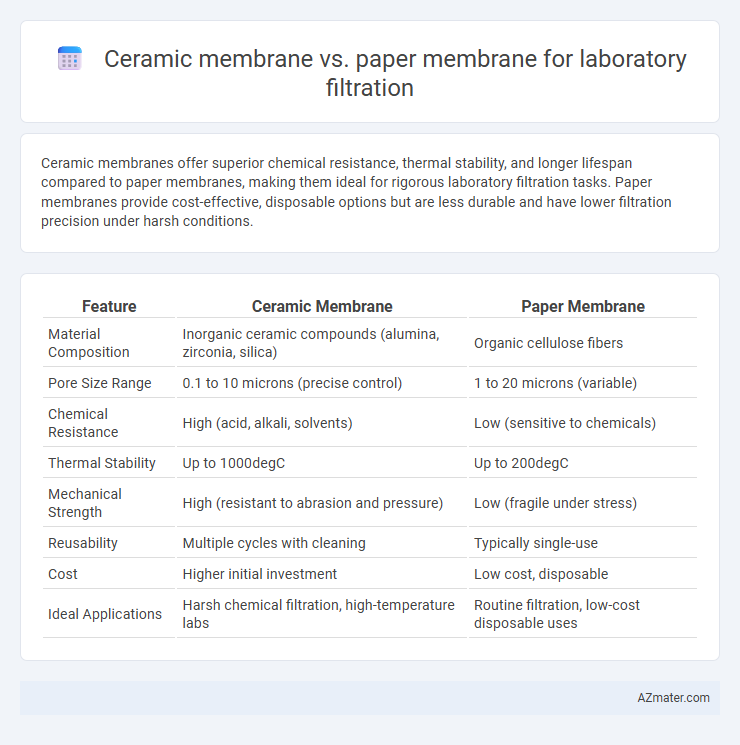Ceramic membranes offer superior chemical resistance, thermal stability, and longer lifespan compared to paper membranes, making them ideal for rigorous laboratory filtration tasks. Paper membranes provide cost-effective, disposable options but are less durable and have lower filtration precision under harsh conditions.
Table of Comparison
| Feature | Ceramic Membrane | Paper Membrane |
|---|---|---|
| Material Composition | Inorganic ceramic compounds (alumina, zirconia, silica) | Organic cellulose fibers |
| Pore Size Range | 0.1 to 10 microns (precise control) | 1 to 20 microns (variable) |
| Chemical Resistance | High (acid, alkali, solvents) | Low (sensitive to chemicals) |
| Thermal Stability | Up to 1000degC | Up to 200degC |
| Mechanical Strength | High (resistant to abrasion and pressure) | Low (fragile under stress) |
| Reusability | Multiple cycles with cleaning | Typically single-use |
| Cost | Higher initial investment | Low cost, disposable |
| Ideal Applications | Harsh chemical filtration, high-temperature labs | Routine filtration, low-cost disposable uses |
Introduction to Laboratory Membrane Filtration
Ceramic membranes offer superior chemical and thermal stability compared to paper membranes, making them ideal for rigorous laboratory filtration applications involving aggressive solvents or high-temperature conditions. Paper membranes, commonly used for their cost-effectiveness and ease of use, are suitable for routine filtration of aqueous solutions and biological samples with moderate filtration demands. Selection between ceramic and paper membranes depends on factors such as sample composition, filtration precision, and durability requirements in laboratory settings.
Overview of Ceramic Membranes
Ceramic membranes offer superior chemical and thermal stability compared to paper membranes, making them ideal for harsh laboratory filtration environments. Their porous structure enables high flux rates and precise separation of particles down to the micro- and nanoscale, enhancing filtration efficiency. These membranes also provide remarkable durability and resistance to fouling, which reduces maintenance and extends operational lifespan in laboratory applications.
Overview of Paper Membranes
Paper membranes in laboratory filtration are composed primarily of cellulose or cellulose acetate, offering high porosity and uniform pore size distribution ideal for precise particle retention. They provide excellent chemical compatibility with aqueous solutions and are cost-effective for routine filtration tasks involving suspension clarification or microbiological analysis. However, their lower mechanical strength and reduced resistance to harsh solvents distinguish them from more durable ceramic membranes commonly used in aggressive chemical environments.
Material Composition and Structure Comparison
Ceramic membranes consist of inorganic materials such as alumina, zirconia, or titanium oxide, providing high chemical and thermal stability, while paper membranes are typically made from cellulose or synthetic polymers, offering biodegradability but lower durability. The porous structure of ceramic membranes features uniform, rigid pores that enable precise filtration and resistance to fouling, whereas paper membranes have irregular fibrous matrices that result in less consistent pore size and reduced mechanical strength. Ceramic membranes excel in harsh laboratory filtration conditions requiring aggressive solvents or high temperatures, whereas paper membranes are suitable for less demanding applications with disposable use.
Filtration Efficiency and Pore Size Distribution
Ceramic membranes exhibit superior filtration efficiency due to their uniform pore size distribution, enabling precise separation of particles down to the nanoscale, which is critical for high-purity laboratory filtration. Paper membranes generally have broader pore size variability, leading to less consistent filtration performance and potential particle penetration. The durability and chemical resistance of ceramic membranes also allow for repeated use and cleaning without compromising pore integrity, unlike most paper membranes that are single-use and prone to clogging.
Chemical and Thermal Resistance Differences
Ceramic membranes exhibit superior chemical resistance, withstanding aggressive solvents, strong acids, and bases that typically degrade paper membranes in laboratory filtration. Thermal resistance of ceramic membranes is also significantly higher, tolerating temperatures up to 500degC, while paper membranes generally degrade above 150degC. These properties make ceramic membranes ideal for harsh chemical environments and high-temperature filtration processes.
Durability and Reusability of Membranes
Ceramic membranes exhibit superior durability compared to paper membranes, with resistance to chemical corrosion, high temperatures, and mechanical stress, enabling extended use in rigorous laboratory filtration applications. Their robust structure supports multiple cleaning cycles without significant performance loss, ensuring efficient reusability. In contrast, paper membranes degrade quickly under harsh conditions, limiting their lifespan and suitability for repeated filtration tasks.
Cost Analysis: Ceramic vs Paper Membranes
Ceramic membranes generally incur higher upfront costs compared to paper membranes due to their durable materials and advanced manufacturing processes. However, ceramic membranes offer longer lifespan and superior chemical resistance, reducing replacement frequency and operational expenses over time. Paper membranes, while more affordable initially, often require frequent replacement and generate higher waste disposal costs, impacting long-term cost-effectiveness in laboratory filtration.
Typical Laboratory Applications for Each Membrane
Ceramic membranes excel in high-temperature and chemically aggressive laboratory filtrations, making them ideal for sample clarification, cell harvesting, and sterilization processes in biopharmaceutical and environmental testing labs. Paper membranes are commonly used for routine laboratory filtration, including particulate removal and microbiological analysis, due to their cost-effectiveness and ease of disposal. Typical applications of paper membranes include bacterial retention, air monitoring, and particulate filtration in environmental and clinical laboratories.
Choosing the Right Membrane for Laboratory Needs
Ceramic membranes offer exceptional chemical resistance, thermal stability, and durability, making them ideal for harsh laboratory filtration applications requiring repeated sterilization or aggressive solvents. Paper membranes provide cost-effective, disposable options for rapid filtration of aqueous samples with moderate chemical compatibility and lower pressure tolerance. Selecting the right membrane depends on factors like sample type, filtration pressure, chemical resistance, and reusability requirements to ensure efficient and reliable laboratory processing.

Infographic: Ceramic membrane vs Paper membrane for Laboratory filtration
 azmater.com
azmater.com